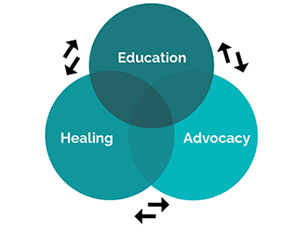Prevention Framework
UCLA CARE Program is dedicated to eradicating sexual violence on campus through a series of frameworks. Through these frameworks, we are able to provide comprehensive prevention education as well as advocacy and healing programs that center the intersections of identities.
Primary, Secondary, and Tertiary Forms of Prevention

Primary Forms of Prevention
Primary forms of prevention aim to prevent sexual violence from occurring. We provide primary prevention educational programs, workshops, and training around topics such as:
- Introduction to CARE
- How to Support Survivors and Trauma-Informed CARE
- Intersections of Identity, Consent, and Supporting Survivors
- Microaggressions
- Redefining Power to Create Healing-Engaged Spaces
- How to Be an Upstander
- Creating Survivor-Centered Programming
- How to Build Coalition Across Difference
- Recognizing the Red Flags: A Workshop on Healthy and Unhealthy Relationships
- Consent
- Healthy Relationships
- Bystander Intervention
- Red Flags

Secondary Forms of Prevention
Secondary forms of prevention provides immediate response after sexual violence has occurred. The CARE office provides advocacy services for those who have experienced sexual violence such as but not limited to:
- Crisis intervention and emotional support
- Resources and referrals for counseling, medical, legal, and other resources as needed
- Developing a safety plan
- Addressing academic, housing, and employment concerns
- Navigating the criminal justice system, Title IX, and/or the Student Conduct Process
- Accompaniment to police, Title IX, and/or Student Conduct interviews, meetings, and hearings
- Obtaining a No Contact Directive/Stay Away Order from the Dean of Students
- Obtaining a Restraining Order
- Healing and Empowerment

Tertiary Forms of Prevention
Tertiary forms of prevention provide long-term support for survivors and address the lasting effects of trauma. The CARE office provides several healing programs that center the experiences of survivors including:
- Trauma-Informed Healing
- Sensory Toolkit
- Mindfulness and Meditation
- Hope and Healing
- HeART
- A Write to Heal

Combined, these three components allow us to address primary, secondary, and tertiary levels of prevention providing a comprehensive approach in service of our mission.
Intersectionality
https://www.youtube.com/watch?v=ViDtnfQ9FHcIntersectionality
Intersectionality refers to intersections of multiple Interlocking systems of oppression such as racism, sexism, homophobia, etc. Coined by Kimberle Crenshaw in her 1989 scholarship, "Demarginalizing the Intersection of Race and Sex" and expanding it in her 1991 scholarship, "Mapping the Margins: Intersectionality, Identity Politics, and Violence against Women of Color".
Social-Ecological Model

The Social-Ecological Model
The Social-Ecological Model helps better understand the complex relationship between the individual, relationship, community, and societal factors that put people at risk for violence. The model represents the overlapping relationships between each level and it is understood that to prevent violence, each level must be addressed individually and at the same time.

Individual Level
"The first level identifies biological and personal history factors that increase the likelihood of becoming a victim or perpetrator of violence. Some of these factors are age, education, income, substance use, or history of abuse. Prevention strategies at this level promote attitudes, beliefs, and behaviors that prevent violence. Specific approaches may include conflict resolution and life skills training, social-emotional learning, and safe dating and healthy relationship skill programs." (Center for Disease Control and Prevention, 2022)

Relationship Level
"The second level examines close relationships that may increase the risk of experiencing violence as a victim or perpetrator. A person’s closest social circle-peers, partners and family members may influence their behavior, and contributes to their experience. Prevention strategies at this level may include parenting or family-focused prevention programs and mentoring and peer programs designed to strengthen parent-child communication, promote positive peer norms, problem-solving skills and promote healthy relationships." (Center for Disease Control and Prevention, 2022)

Community Level
"The third level explores the settings, such as schools, workplaces, and neighborhoods, in which social relationships occur and seeks to identify the characteristics of these settings that are associated with becoming victims or perpetrators of violence. Prevention strategies at this level focus on improving the physical and social environment in these settings (e.g., by creating safe places where people live, learn, work, and play) and by addressing other conditions that give rise to violence in communities (e.g., neighborhood poverty, residential segregation, and instability, high density of alcohol outlets)." (Center for Disease Control and Prevention, 2022)

Societal Level
"The fourth level looks at the broad societal factors that help create a climate in which violence is encouraged or inhibited. These factors include social and cultural norms that support violence as an acceptable way to resolve conflicts. Other large societal factors include the health, economic, educational, and social policies that help to maintain economic or social inequalities between groups in society. Prevention strategies at this level include efforts to promote societal norms that protect against violence as well as efforts to strengthen household financial security, education and employment opportunities, and other policies that affect the structural determinants of health." (Center for Disease Control and Prevention, 2022)
